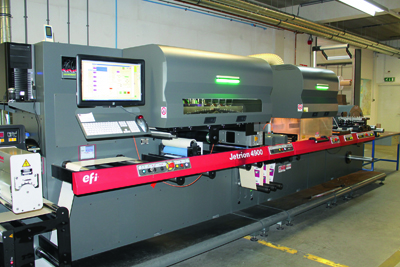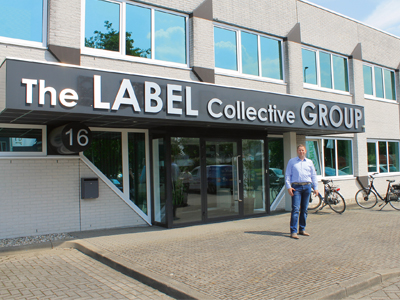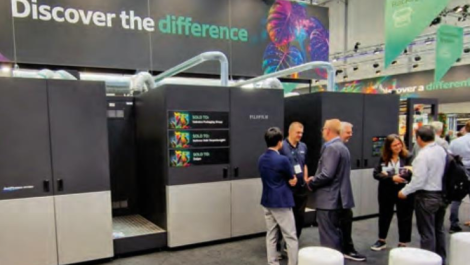TLCG owner, Richard Rensen
Cornering the European market in blank labels for Dymo machines and offering an efficient web-to-print portal for digital labels has proved a winning combination for The Label Collective Group in the Netherlands. Neel Madsen went to see the company that up until three years ago had never produced printed labels before.
Turning customers’ artwork into printed labels and shipping them in just 24 hours is the key to the success of The Label Collective Group (TLCG) in Haaksbergen, the Netherlands. Since 2009, the company, which today supplies both blank and colour printed self-adhesive labels, has grown exponentially from just a few customer to 27,000, in no small part due to the drive and determination of owner, Richard Rensen. He said, ‘I’m not from a printing background, but my philosophy is that if you want to sell a product, you have to be in charge of production. We didn’t want to be a reseller of colour labels, so we bought an inkjet press and learned how to print.
And thus, by sheer determination and investment in EFI Jetrion technology, Mr Rensen added high quality, full colour labels to his repertoire and has in the past three years supplied labels that end up with many household names and big brands, mainly through agencies or flexo printing companies that don’t have digital technology themselves. The company is largely a trade printer with only 30% of volume produced directly for the end user, all sold through its online portals.
Let’s give it a go
Label printing first appeared on Richard Rensen’s radar when he was managing the Enschede branch of Cash Converters and wanted to sell and ship items that had not be reclaimed. Buying in small quantities of shipping labels was very expensive so he went directly to a trade printer and started buying in bulk. He quickly realised there was an opportunity in reselling labels, and over the next few years was very successful.
‘I could see there was a great business opportunity in reselling labels and thought I would give it a go,’ he explained. ‘We started selling through eBay initially using European suppliers. I then moved to China for a few years to oversee production at a manufacturer there, but eventually decided to set up my own print facility here in the Netherlands.’
Six years down the line and TLCG is a hugely successful web-to-print operation selling not only blank labels, but also high quality colour labels to customers all over Europe. The company has recently moved into a 4000 square metre facility to accommodate the constantly expanding operation, and according to Mr Rensen, this will not be the last move, as growth year-on-year has been between 70 and 80%.
Simplicity is key
The company’s web-to-print model keeps costs down by offering a narrow selection of label types at competitive prices. When ordering labels online through TLCG’s Label Discounter or Etikett XL portals, customers simply choose one of the three substrates offered (paper, PP and PET), the type of adhesive, and the size and number of labels, then upload the artwork, pay for the job and press send.
And this is where the EFI Jetrion fits so well. Mr Rensen said, ‘The flexibility and the fast changeover of jobs is a huge advantage. No dies or plates – we simply enter the job into system and print it. It is perfect for our business model.’
The pricing structure does demand that the artwork is correct from the beginning, so if there are any issues when the job goes to print, it will be returned to the customer to be amended. Although some 70 to 80% of labels are sold to agencies or other online models, Mr Rensen said that the aim is to get that number up to 95%, as end users often do not understand the printing parameters or do not supply the right artwork, which is too time consuming.
Labels are supplied for a vast variety of functions, often incorporating variable data. These include seasonal and regional promotional labels, such as one large supermarket chain which needs labels for its 200 stores so each individual outlet can sell discounted products as needed. Key labels for a large chain of holiday parks was another job incorporating VDP, as was labels for clothes recycling bags that needed to be traceable through a government scheme.
This business model may seem simple, but it has proved so effective that working 6am to 10pm shifts is no longer enough to meet demand, and Mr Rensen is actively expanding the current staff of 18. A new head of production has already been appointed along with a new sales manager, both joining from one of TLCG’s main competitors.

The EFI Jetrion 4900ML 330 mm wide press
New wider press
Production was significantly increased after a new EFI Jetrion 4900ML 330 mm wide press was installed in December last year. This machine replaced an older Jetrion from 2012, and Mr Rensen commented it was remarkable how much the press has improved in just a few years. He praised the wider width of the machine, saying, ‘With a 330 mm print width, we can print label sizes up to 250 x 470 mm. Or we can print two side by side, or if a label is 80 mm we can print four side by side.’
The EFI Fiery XF DFE gives the press its processing power. This high-speed digital front end provides high levels of performance and image quality even on complex jobs. ‘The press fits in exceptionally well with our web-to-print business model as the DFE links in with our Esko Automation Engine to form a seamless workflow. Between order input online to finished product, we only need one employee.’
The inline finishing was another major plus point for TLCG and its ability to turn orders into finished labels within 24 hours. ‘The new laser uses 95% of its power for die-cutting and only 5% ends up in the substrate – this used to be 25%,’ said Mr Rensen. ‘The benefit is that our labels come off the roll much more easily and are more suitable for further processing using automatic labelling machines.’ He continued, ‘We have a special laser for cutting PP substrates and it is so easy to work with. We don’t need any dies or magnet cylinders, and we can run two or three different jobs right next to each other. This saves so much time and costs.’
Much more to come
Mr Rensen’s enthusiasm about the Jetrion is obvious and he more than hints that the purchase of a second machine is on the horizon. He said, ‘I particularly like how user friendly this press is. You don’t need any of the traditional operator skills; anyone with computer skills can quickly learn to run it.’
The press is also part of his plan to future proof the company as he predicts the blank label side of the business will decline. This currently makes up 80% of volume and colour inkjet labels the remaining 20%. Mr Rensen predicts that in the next five years, the large production hall will fill up with up to 40 new machines, largely printing presses, but also packing machines, and that colour label printing will become the mainstay of the business.
His latest investment in a Neopost CVS-500 packing line proves his ability to think laterally. This innovative, fully automated machine is described as a ‘fit-to-size order packing system’ that enables companies selling online to pack orders of any shape and size quickly, whilst saving on packing material and space. TLCG is only the fourth company to install this piece of equipment.
The story of TLCG is not one of a traditional printing company, but one of an entrepreneur who saw an opportunity in labels and found the right technology for his vision. ‘We are not specialist printers. Our success comes from meeting our customers needs and not thinking like a printer, but looking at the demand and supplying a product that is high quality, delivered quickly to the customers’ specification. It’s simple and effective,’ concluded Mr Rensen with a big smile on his face.






